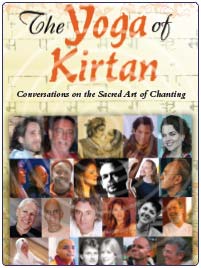Book Review: The Yoga of Kirtan
By Lakshmi Nrisimha Dasa | Jul 12, 2008

Steven Rosen (Satyaraja Dasa), prolific author and renowned expert on Gaudiya Vaishnavism, has hit new strides with his latest literary offering – a book about kirtan, the sonic form of yogic spirituality. The Yoga of Kirtan is truly a groundbreaking celebration of yogic practice, engaging 21 well-known kirtan singers in conversation – transcribed interviews. Their insights give readers a comprehensive understanding of what chanting actually means, both in terms of practical application and inner development.
Bhaktivinode Thakur, one of the world’s most profound and versatile devotional writers from 19th-century India, has encouraged his readers, regardless of culture or religious affiliation, to seek out saragrahis (“truth seekers”) from all traditions. His words ring loud and true today in our modern, globalized world, which has now exposed the potential of spiritual chanting to a broad, multi-denominational audience.
Along the lines of Bhaktivinode’s mandate, Satyaraja managed to locate representatives of the kirtan tradition in its many manifestations and conducted interviews revealing the phenomenal effect chanting has had on these individuals in their lives and work. I found all of the interviews engaging and informative and particularly liked the revelations of Shyamdas, Vaiyasaki, Bhakti Charu Swami and Krishna Das. But all of the interviews provide a riveting and specific glimpse into each artist’s calling as a kirtaniya. By making good use of the warm and friendly interview format, with its highly accessible conversational tone, Satyaraja, like an archeologist, has successfully unearthed artifacts of kirtan knowledge and lore, revealing little known details of its history, performance, and esoteric meaning.
Most readers, then, will naturally be fascinated by the interviews – which make up more than 80% of the book, offer a good read, and indeed contain more than a lion’s share of valuable information on kirtan. However, I found the other sections of the volume even more illuminating.
The dedication itself – to “the kirtan tree” in New York City’s Tompkins Square Park – sets the tone and establishes the importance of His Divine Grace A. C. Bhaktivedanta Swami Prabhupada, who held the first outdoor kirtan in the Western world (in 1966) in front of this very tree. The Prologue picks up from there, explaining the nonsectarian and universal power of the holy name. It shows how kirtan exists in all religious traditions and is a practice that can easily enhance one’s spiritual life – regardless of one’s particular affiliation or non-affiliation.
The Introduction is a gem of writing as Satyaraja talks about the first time he ever witnessed kirtan, personally, when he was just a teenager attending a rock concert in New York. From there, he shows his time-earned knowledge as a scholar, launching into specifics about kirtan terminology, explaining the various instruments used in kirtan performance, and detailing the history of sacred chant in India. He looks at Vedic mantra, esoteric poetry, and the power of sound.
This leads to his deep if also easily absorbed explanation of the maha-mantra (Hare Krishna, Hare Krishna, Krishna Krishna, Hare Hare/ Hare Rama, Hare Rama, Rama Rama, Hare Hare), which may be the most important part of this already astounding Introduction. Satyaraja here explains why it is considered the best of all mantras, how it is nondifferent from God, contains the potency of all other mantras, and even champions the cause of women’s rights by accentuating Sri Radha, the female dimension of the Supreme.
It is urgent to understand – and the book makes it clear — that the maha-mantra is not the exclusive property or penchant of one small Gaudiya Vaishnava sect. It is “the great mantra” that, if approached openly, honestly and with great sincerity, will clear the heart of all misgivings and doubt about one’s constitutional position as spirit soul. It is virtually impossible to taste honey by licking the outside of a honey bottle, and the unlimited, boundless bliss that is contained in this mantra of mantras can only be approached when one recognizes the amalgam of personality and sound that exists in its sweet recitation. The book inspires one to enthusiastically open the jar and to taste the honey! Satyaraja’s lucid insight into the domain of this mantra is a great service to the yogis and yoginis of the world, no matter what specific discipline they might adhere to. Thus, the Introduction gives the reader all necessary background, so that now the interviews will have greater meaning.
And then there are the appendices. As a 35-year practitioner of Bhakti Yoga under the guidance of His Divine Grace A. C. Bhaktivedanta Swami Prabhupada, I was keenly interested in the appendix that dealt with the sacred syllable OM. Every yoga practitioner has come in contact with this most sacred of sound vibrations, yet its complete understanding has always been shrouded in the esoteric explanations of various Vedic texts, and in the writings of modern-day yoga teachers. In that short segment of the book, however, Satyaraja has given me enough information on the meaning of OM to keep me pondering for a lifetime – clarifying the little bit I had previously understood from Vedic and modern sources. I lecture frequently on the Vedas, specifically from the Gaudiya Vaishnava perspective, and so this section will find a home in my personal reference library.
The other appendix, on Sri Chaitanya, the “father of modern kirtan,” is equally valuable. Numerous books have been written about the life and teachings of Chaitanya Mahaprabhu. But those works have pretty much remained the exclusive property of the Gaudiya Vaishnavas and, to a much lesser degree, South Asian scholars. Although Srila Prabhupada made Sri Chaitanya readily available through his easily approachable translations and purports, the appendix in this book gives even the casual reader some significant if also encapsulated insight into just who He is, underlining His divine importance in the landscape of the kirtan world. Few yoga practitioners, in fact, are aware that it was Chaitanya Mahaprabhu who broke open the storehouse of love of God and distributed it freely to the common people through the medium of kirtan. Indeed, it is virtually impossible to understand the profundity and emotional depth of sacred chant without recourse to His divine personality.
In short, this book is a must read for the seasoned yogi or yogini, but it is also a must for the neophyte practitioner and even for the mildly curious. Both teachers and students of Hinduism will also find much between these covers. Add to that a CD with over 70 minutes of kirtan music, and this is a package that is not to be missed.
Available from: www.yogaofkirtan.com















